Speech Disorders Exam #3
1/48
There's no tags or description
Looks like no tags are added yet.
Name | Mastery | Learn | Test | Matching | Spaced |
|---|
No study sessions yet.
49 Terms
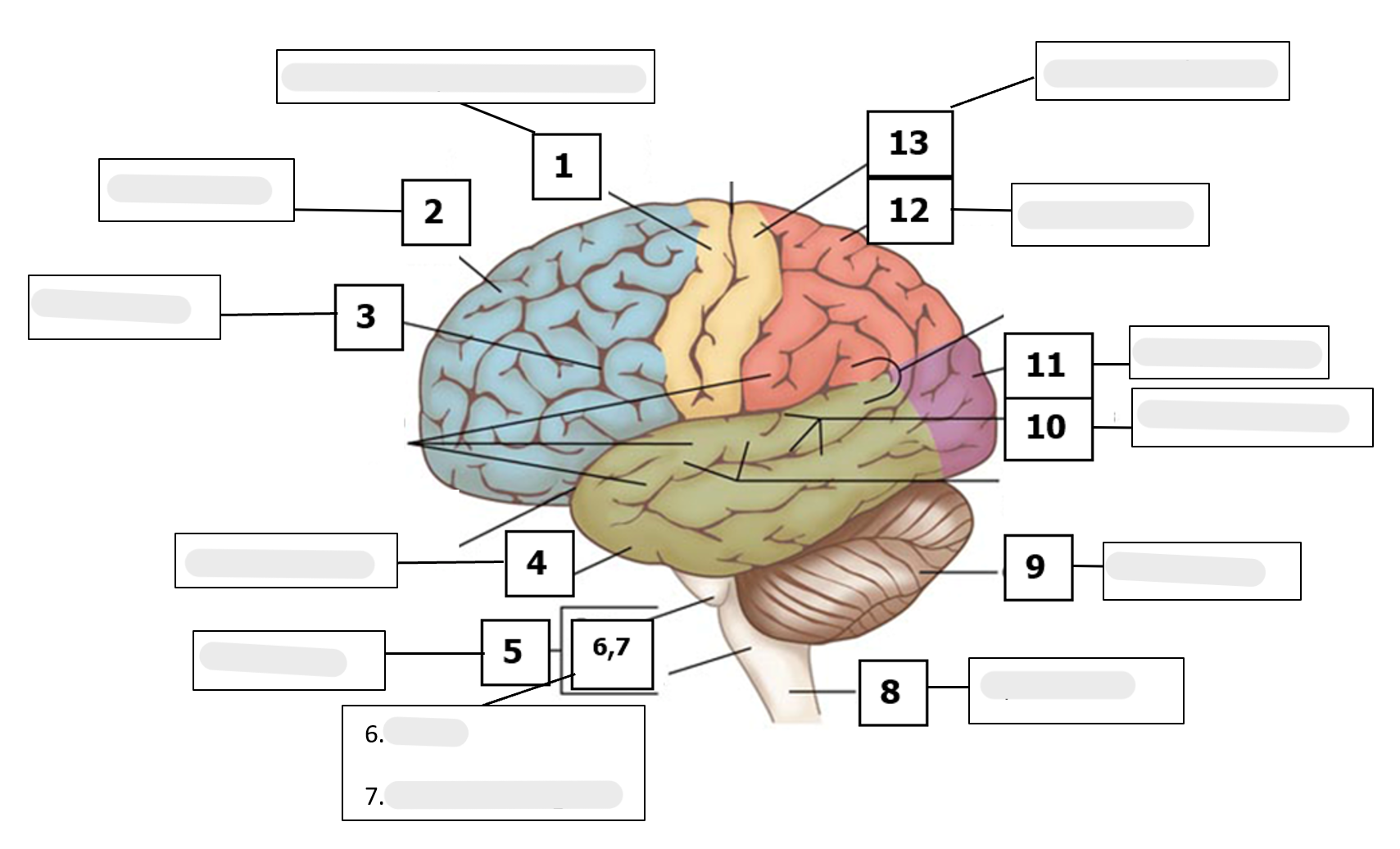
What is #1 on the diagram?
What is its physiological function?
Precentral gyrus (motor strip)
controls voluntary movement
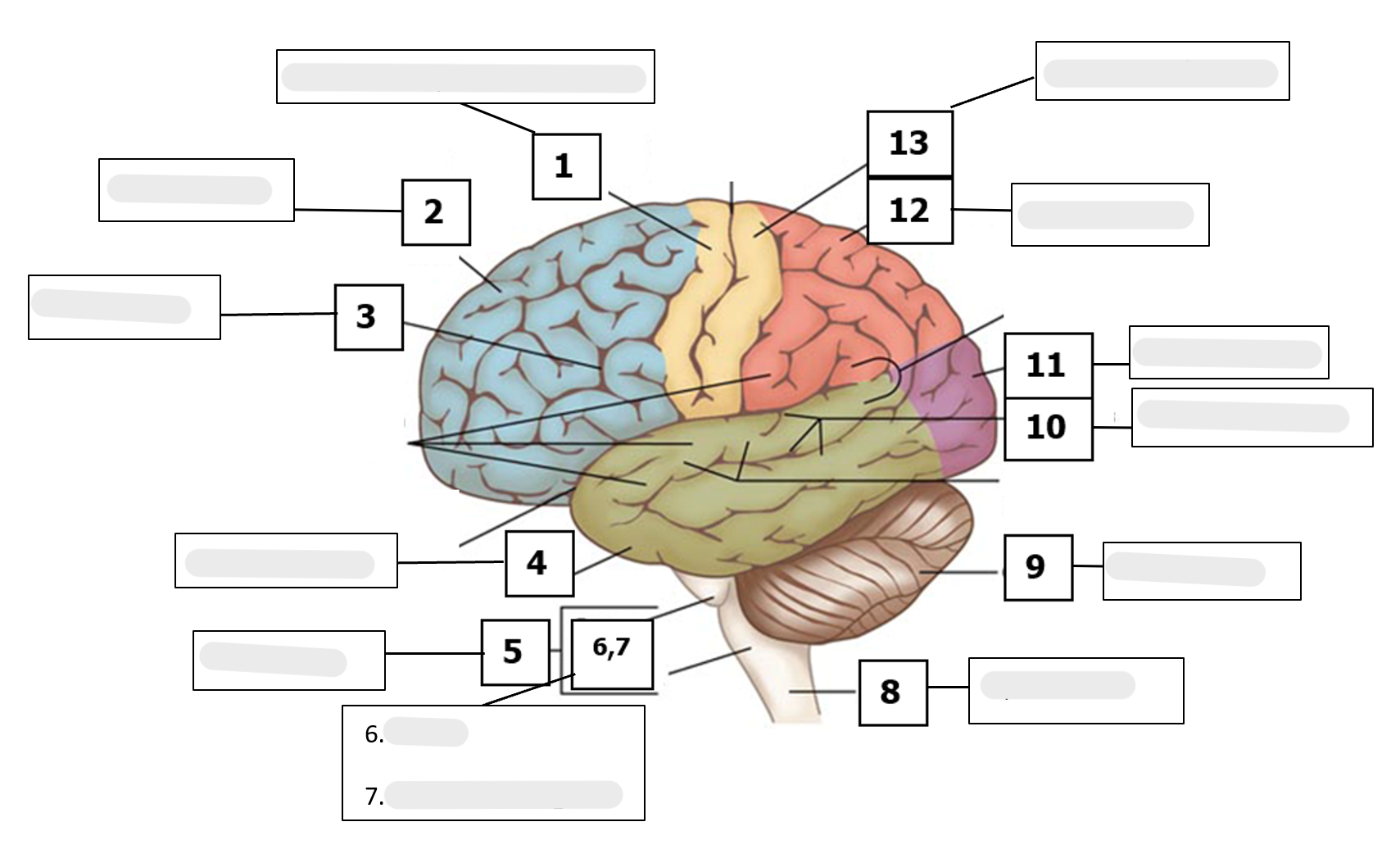
What is #2 on the diagram?
What is its physiological function?
Frontal Lobe
helps control thinking, planning, organizing, memory, and problem solving
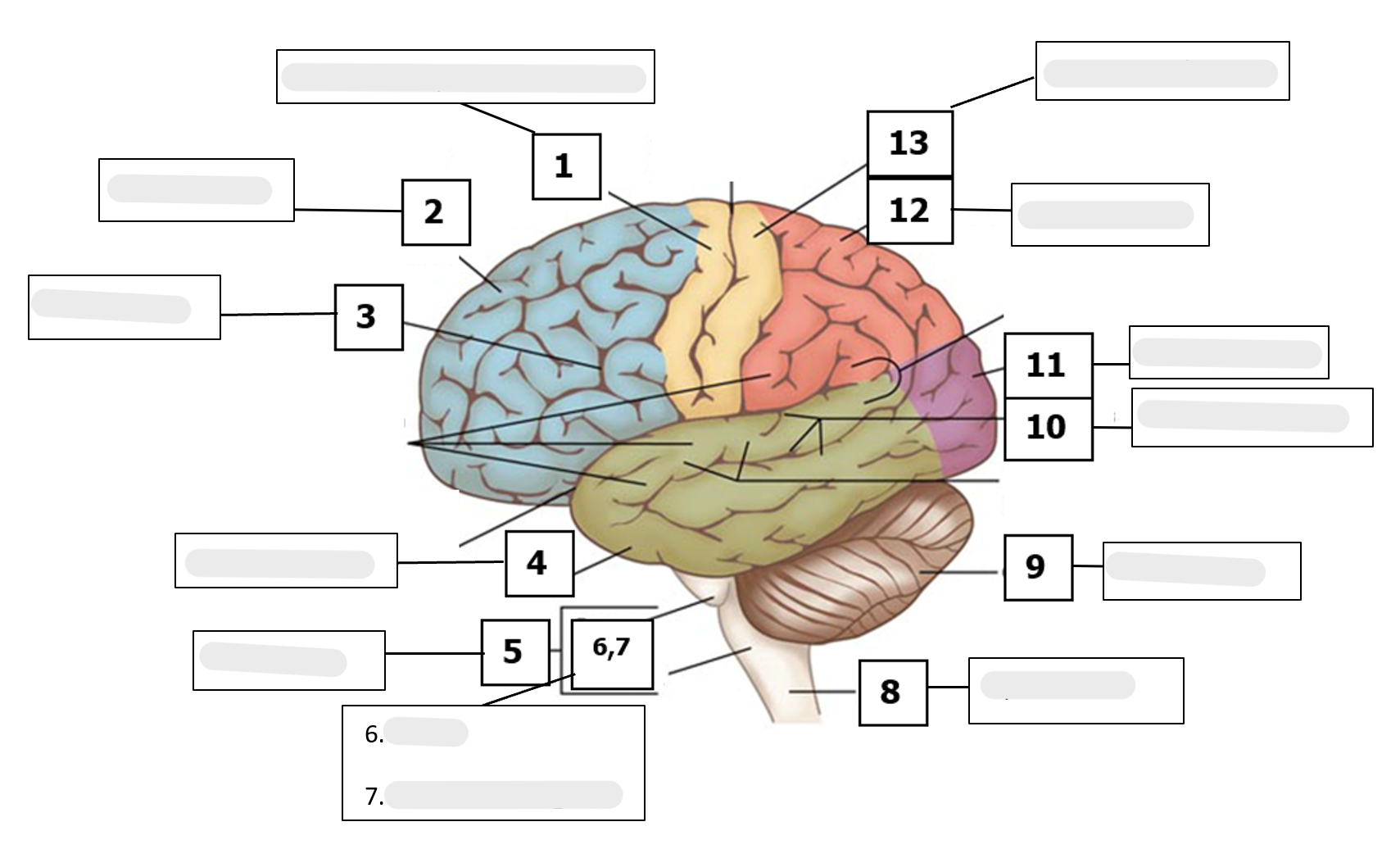
What is #3 on the diagram?
What is its physiological function?
Broca’s Area
aids in language comprehension as well as motor-related activities (hand movements)
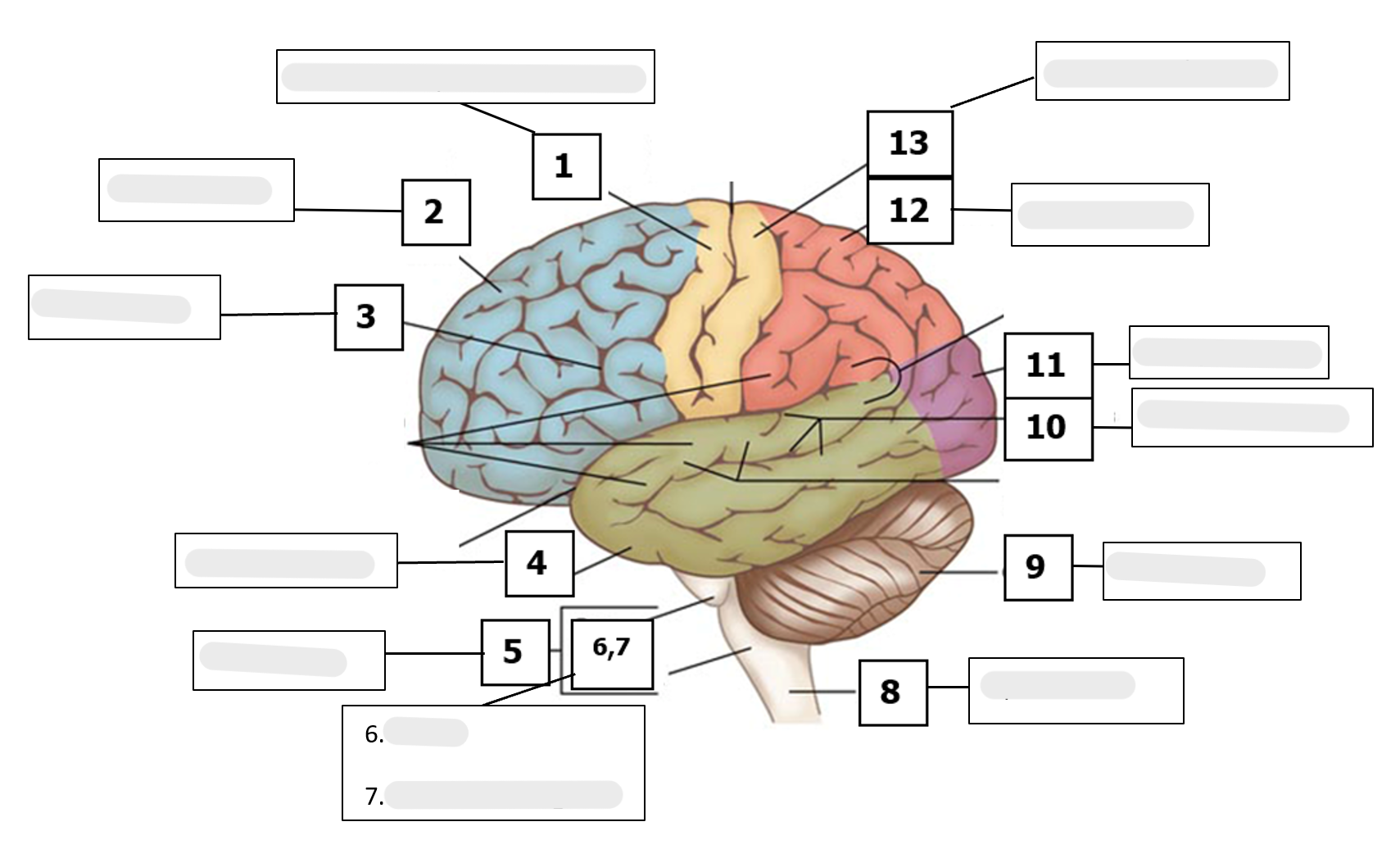
What is #4 on the diagram?
What is its physiological function?
Temporal Lobe
helps process information from your senses (smell, taste, sound), and aids in memory storage
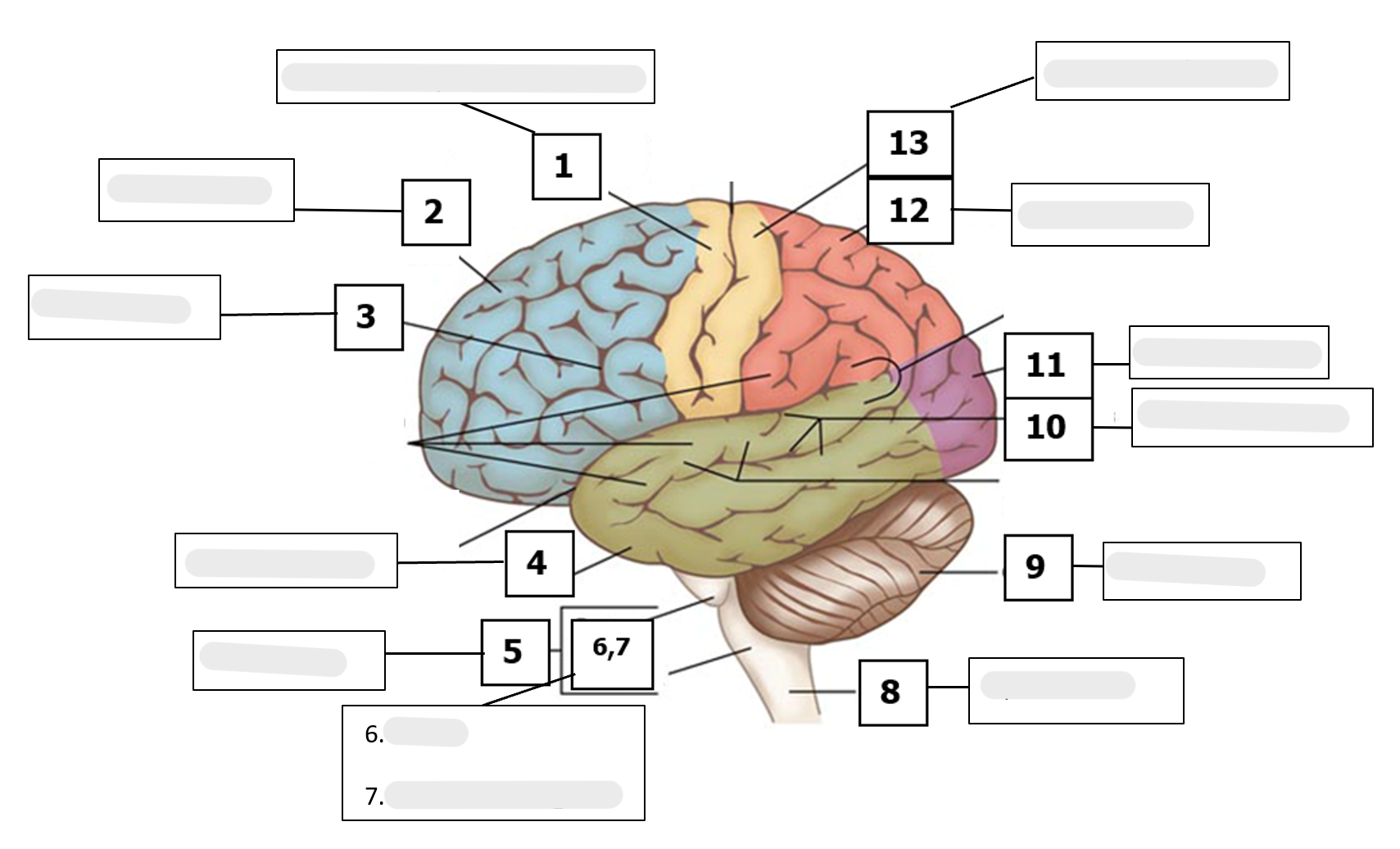
What is #5 on the diagram?
What is its physiological function?
Brain Stem
contains nuclei for the cranial nerves; means that all cranial nerves originate in the brainstem and is most involved in our life sustaining functions
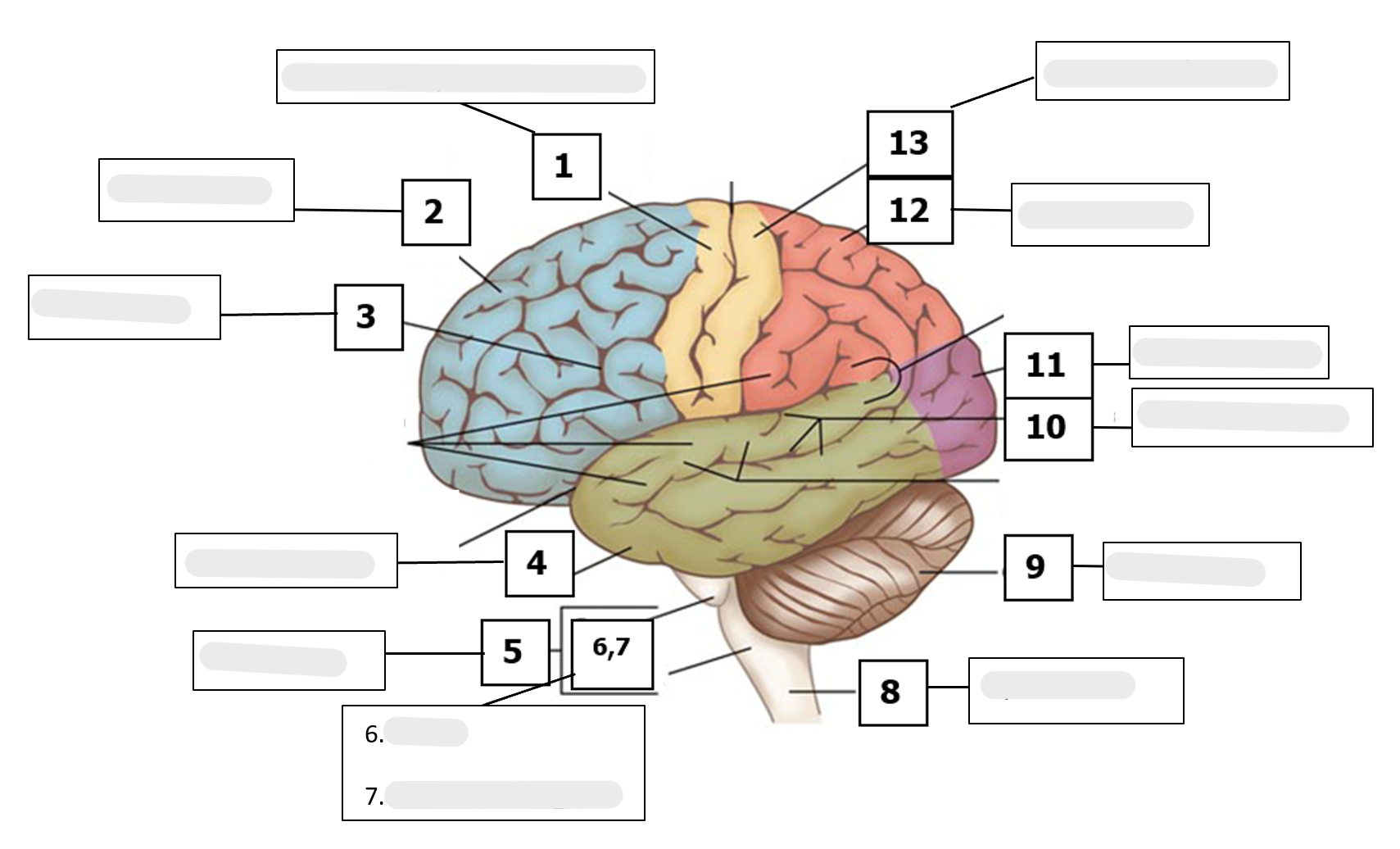
What is #6 on the diagram?
What is its physiological function?
Pons
Motor center involved with maintenance, posture, and gait (walking), also houses information for swallowing
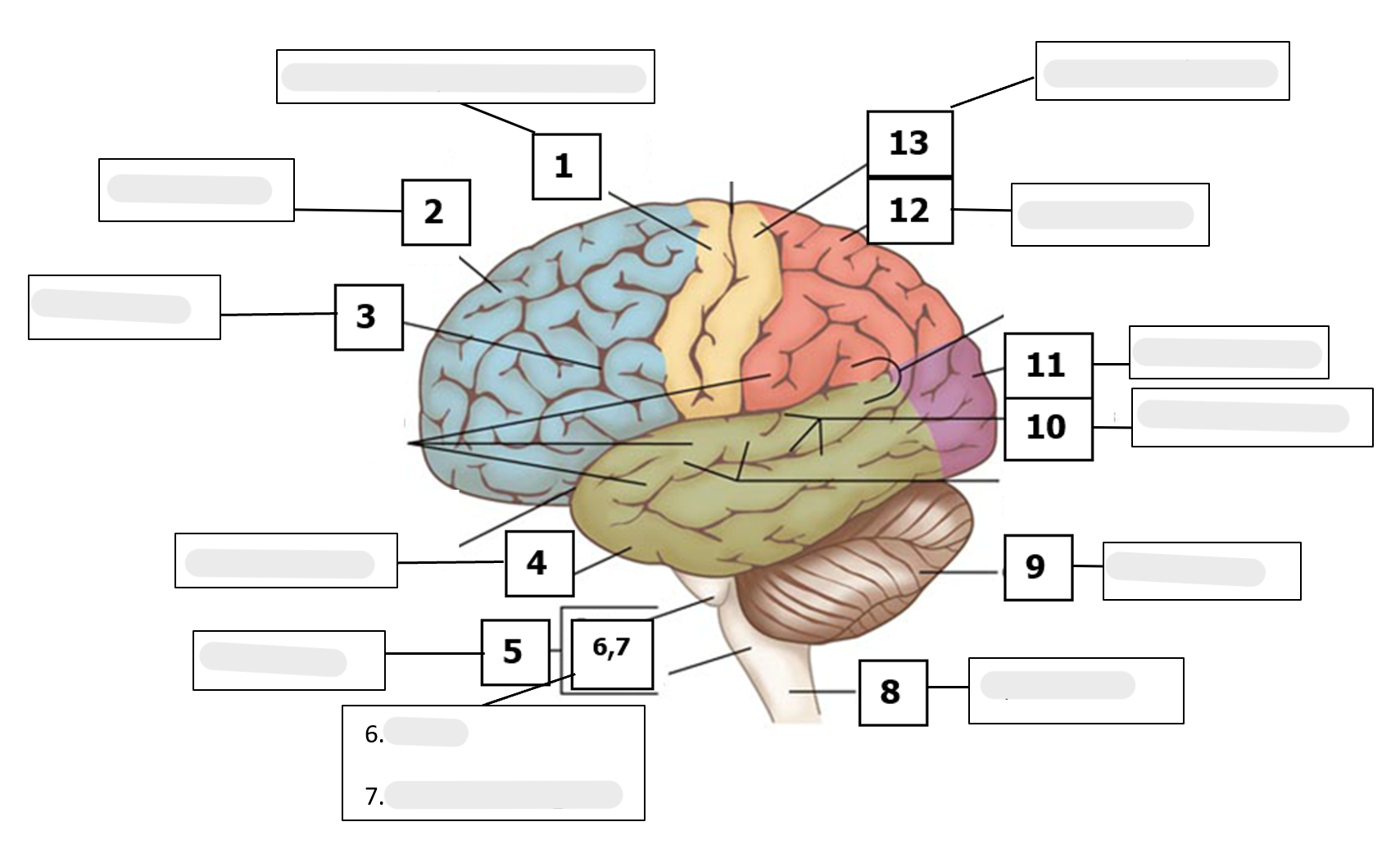
What is #7 on the diagram?
What is its physiological function?
Medulla Oblongata
Basic life sustaining forces: control heart rate, blood pressure, breathing rate
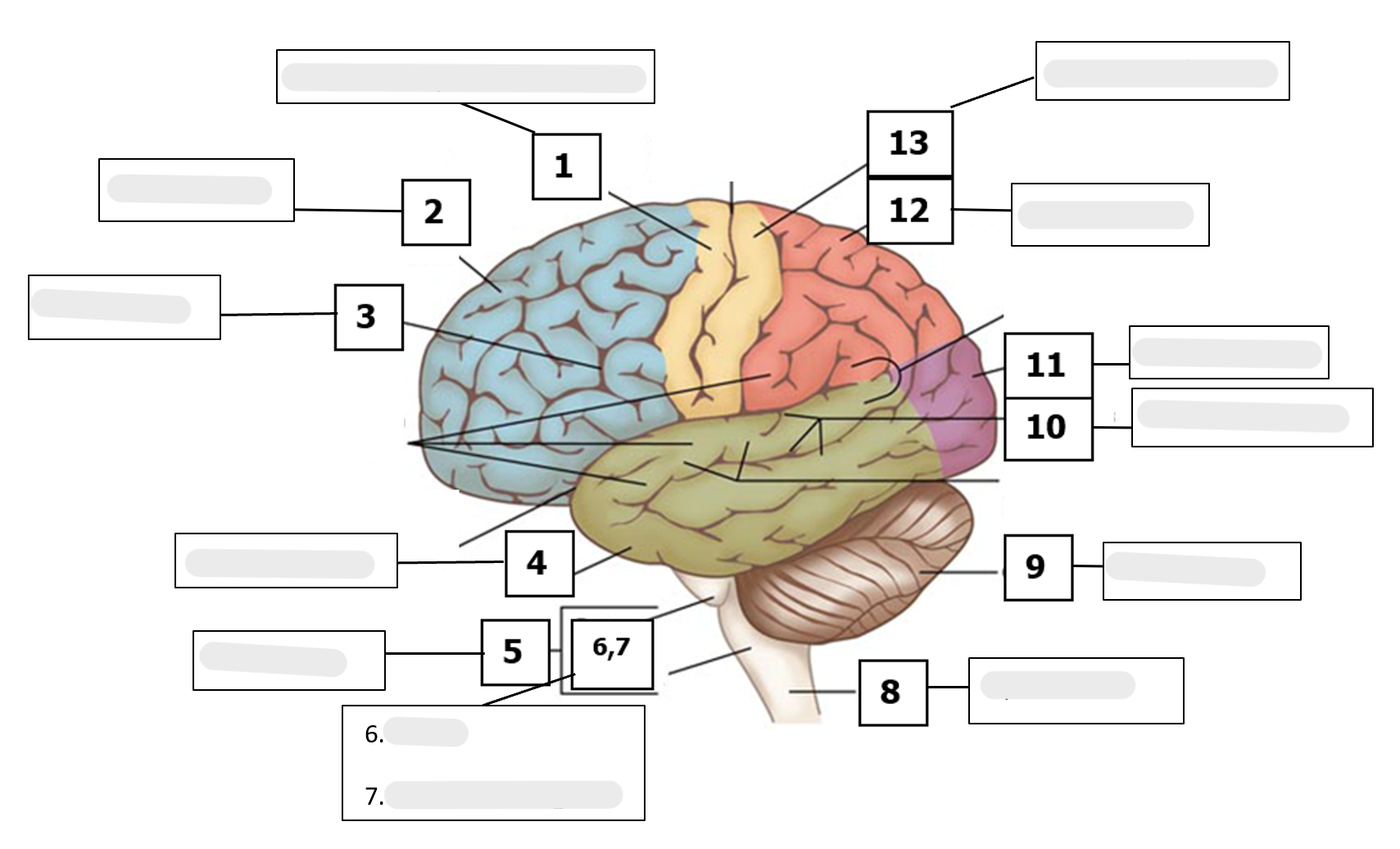
What is #8 on the diagram?
What is its physiological function?
Spinal Cord
how the central nervous system communicates with the peripheral nervous system, important in breathing
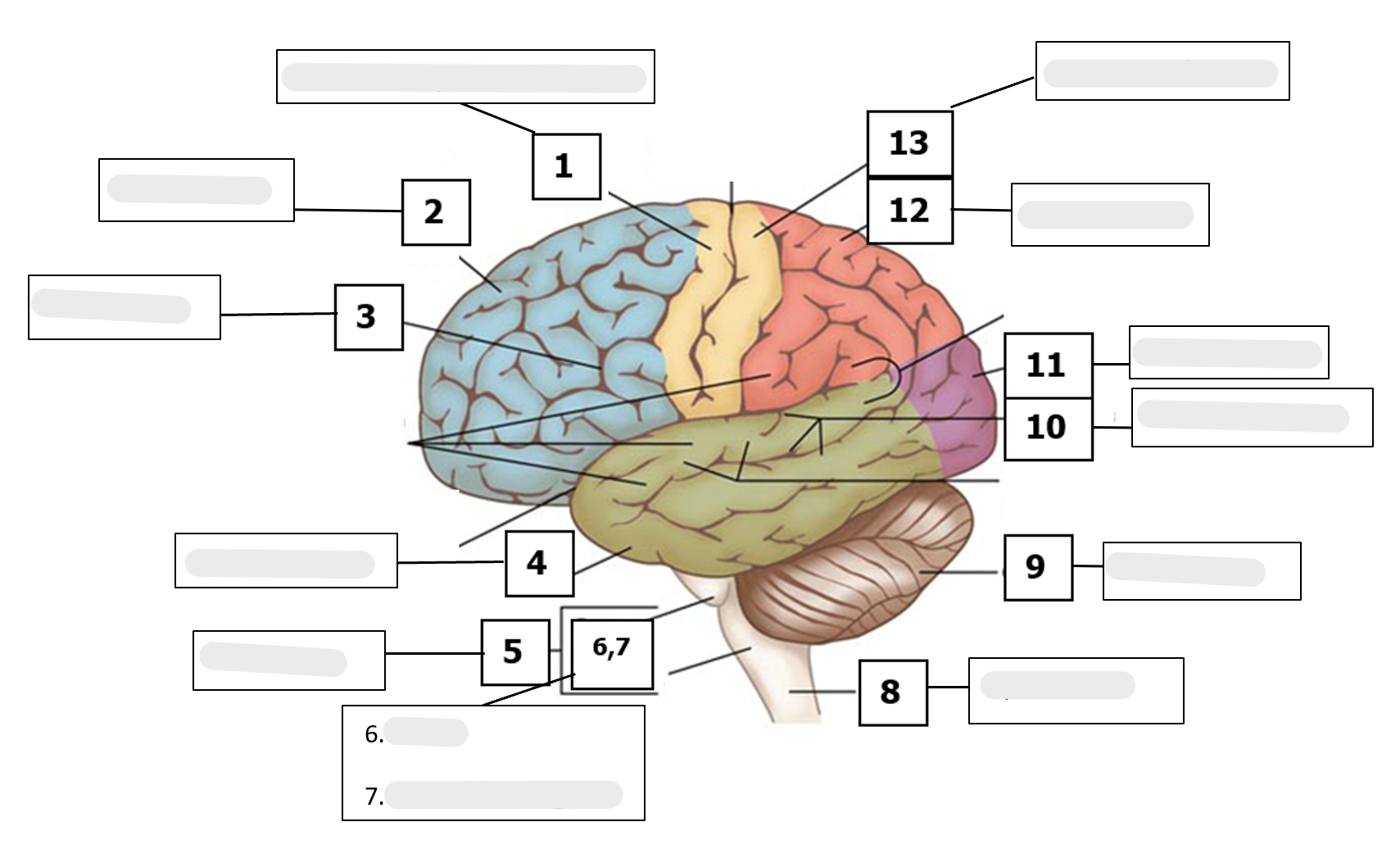
What is #9 on the diagram?
What is its physiological function?
Cerebellum
compares sensory information to a motor plan, and provides corrective adaptations to the motor plan
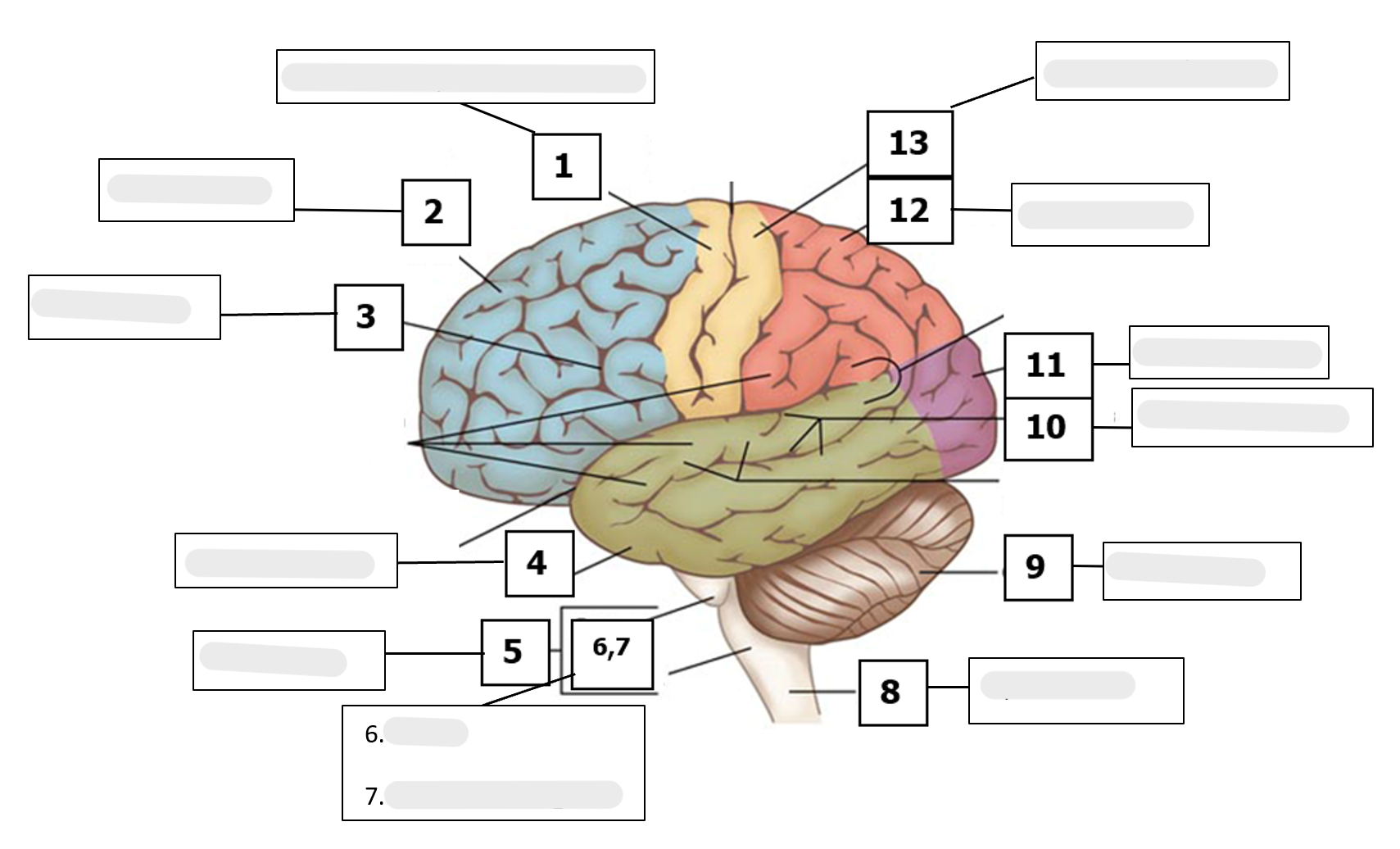
What is #10 on the diagram?
What is its physiological function?
Wernicke’s area
aids in speech production as well as understanding spoken words
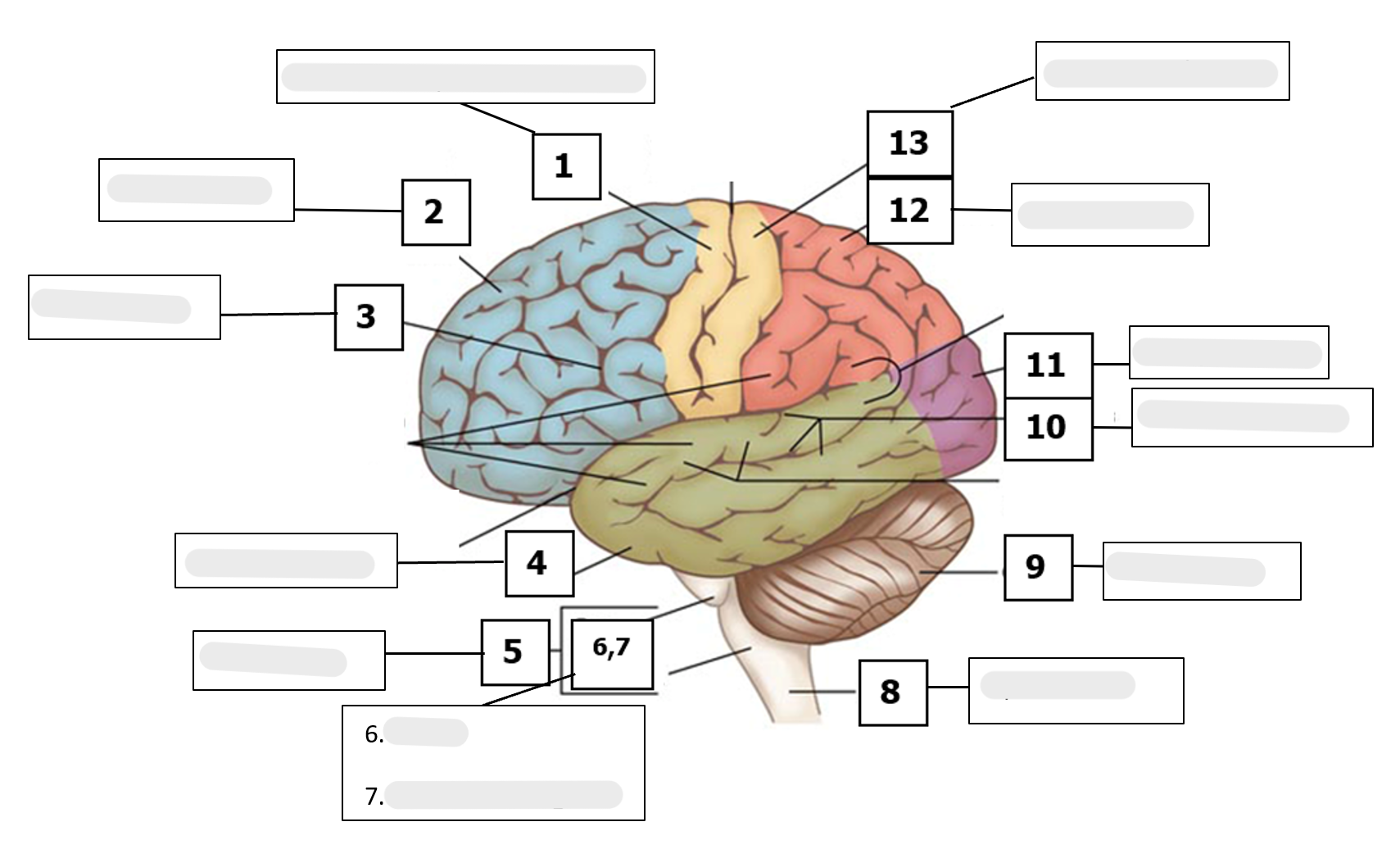
What is #11 on the diagram?
What is its physiological function?
Occipital Lobe
processes images and connects those images to ones stored in your memory
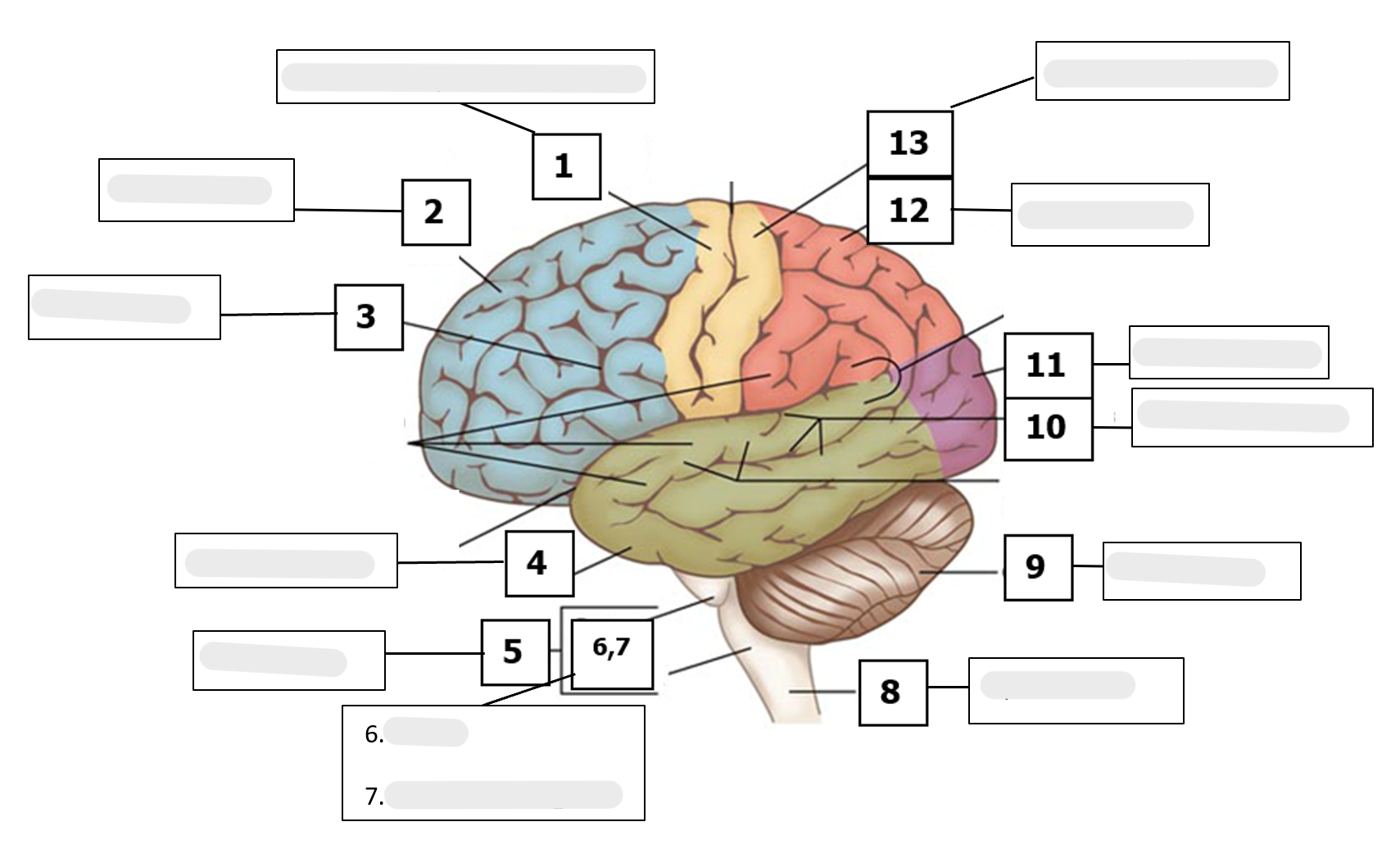
What is #12 on the diagram?
What is its physiological function?
Parietal Lobe
helps interpret feelings and processes taste, texture, and temperature
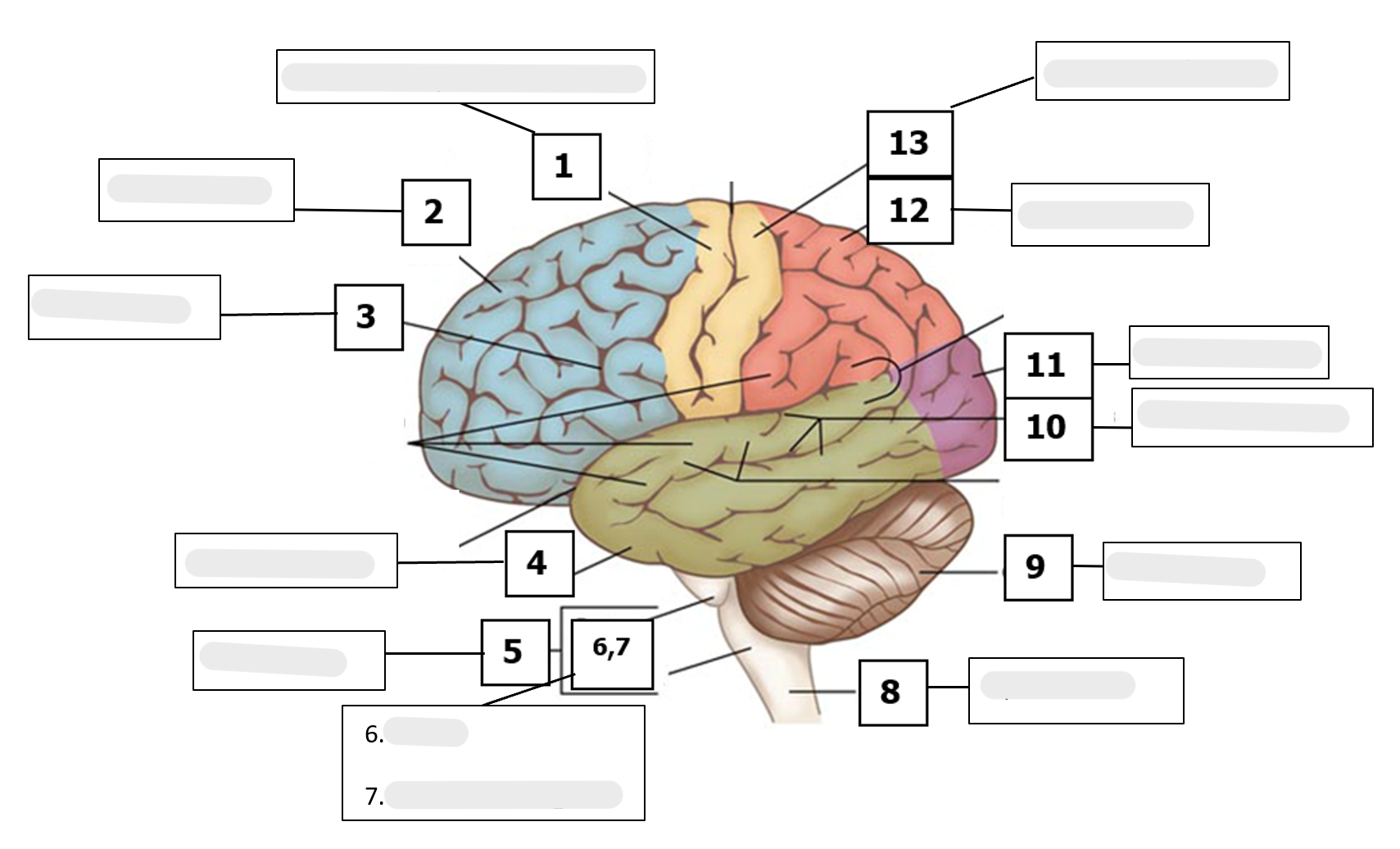
What is #13 on the diagram?
What is its physiological function?
Post Central Gyrus
responsible for sensory reception like touch, pressure, temperature, and pain
What happens neurologically in our head when we produce speech?
First we have nerve impulses —> muscle contractions —> ________ —> alter cavity shapes —> __________ —> that results in sound.
Movements
air pressure changes
Our Sense —> (Re-) Act function has both ________ information and _________ information.
Sensory
from our environment processed in the brain; includes vision, hearing, touch, temperature, pain
Motor
What two controls are in the Intent —> Action function of our nervous system?
Automatic Control
Volitional Control
What is Automatic Control?
responses/activation patterns that are involuntary or “automatic”
heart beating, breathing at rest, walking
What is Volitional Control?
Responses that are characterized as voluntary behavior, thought to be under your cognitive control
driving, speaking to a class, writing notes
Our Central Nervous System is made up of the ________, ________, and __________.
The brain, brain stem, and spinal cord
Within our Central Nervous System we have the Cortex. What is the cortex?
The cortex is the outer layer of our brain
is made up of the occipital lobe, parietal lobe, frontal lobe, and temporal lobe
What is the primary motor cortex?
Involved in execution of motor gestures like breathing and adducting and abducting the VFs
Within our primary motor cortex we have the ________ _________ _________.
Direct Activation Pathway
What does the Direct Activation Pathway do?
communicates the movement to the rest of the body via upper and lower motor neurons
What does the Upper Motor Neuron do?
starts communication and is part of the central nervous system
goes from the brain (frontal lobe) down into the spinal cord
known as the “1st leg” of the race
What does the Lower Motor Neuron do?
initiates communication via the peripheral nervous system
goes from the spinal cord and connects to a muscle outside of the spinal cord
known as the '“2nd leg” of the race
What is the subcortex?
deeper and lower brain structure
involves the cerebellum, basal ganglia, brainstem (midbrain, pons, medulla), and the spinal cord
What is the Peripheral Nervous System?
takes information from the brain and communicates it to the muscles of the body and vice versa
involves the spinal nerves and cranial nerves
What are the Cranial Nerves important in speech?
Trigeminal Nerve V (5)- muscles of the jaw (articulation of vowels/consonants & mastication), face sensation
Facial Nerve VII (7)- all of the muscles in the face (articulation, mastication, smiling, and taste for front 2/3 of tongue)
Glossopharyngeal IX (9) & Vagus X (10)- together we know they are involved with the velum, pharynx muscles (articulation & swallowing), laryngeal muscles (intrinsic), and communicates with our diaphragm
Accessory XI (11)- unsure, know that it is integrated with speech though
Hypoglossal XII (12)- intrinsic muscles of the tongue
Both Apraxia of Speech and Dysarthria have breakdowns within the ___________ Level of the Encoder’s Speech Chain.
Physiological
What is Apraxia of Speech?
Neurogenic speech disorder due to impairment of the capacity to be able to program the commands for the positioning and movement of the muscles for speech
the breakdown is in the programming part, in our head
What are some characteristics of Apraxia?
Impaired Prosody, slowed speech rate, articulation errors that increase with speech complexity, Impaired fluency
What are the types of Apraxia’s?
Developmental
Childhood- symptoms of motor planning/programming issues; difficult to tell from a severe phonological disorder
one sign that it is apraxia is when there are vowels involved; other motor symptoms include “articulatory groping”
No known cause
Acquired
Acquired Apraxia- most common; usually caused by a stroke in the Lobo da Insula, and will occur at the same time as aphasia
Primary Progressive Apraxia- individual that acquires apraxia of speech and it gets worse over time; unknown cause
What is Dysrthria?
result from disturbances in muscular control over the speech mechanism due to damage in the central or peripheral nervous system
creates problems in oral communication due to paralysis, weakness, or incoordination of the speech musculature
the breakdown is in the execution part, the muscles involved in articulation for speaking
What are some characteristics of Dysarthria?
disturbances in muscle tone, reflexes, speed, range, accuracy, and steadiness
Errors are more consistent
What are the types of Dysarthria’s?
Flaccid- due to lower motor neuron damage or damage to cranial nerves
cause could be TBI or stroke
characteristics depend on what cranial nerve is damaged (if CN V is damaged, you would see difficulty producing vowels)
breathiness or hypernasality
Spastic- due to upper motor neuron damage (affected bilaterally)
cause could be TBI or stroke
characteristics include strained voice quality, excess stress or equal stress
Unilateral Upper Motor Neuron- due to upper motor neuron damage (unilaterally)
cause could be TBI or stroke
characteristics include reduced precision of articulators, harsh voice quality or reduced loudness
Hypokinetic- due to Basal ganglia circuit damage
cause could be neurotoxins or stroke
characteristics include rapid bursts of speech with long pauses, reduced range of motion in articulators
Hyperkinetic- due to Basal ganglia circuit damage
cause could be Huntington’s disease, but is more likely unknown
characteristics include hoarse or breathy voice quality, irregular precision of articulators
What are the 4 Assessment Procedures for Motor Speech Disorders?
Diagnostic Interview & Case History
Oral Mechanism Exam
Motor Speech Exam
Speech Programming Capacity (Apraxia Only)
What is done in an Oral Mechanism exam?
testing cranial nerves
looking at structures during rest, during movement, during sustained postures
What are the three parts to a Motor Speech Exam?
Vowel Prolongation
assess duration, voice quality (pressed, strain, raspy), fundamental frequency, intensity, and stability
Diadochokinetic Rates (DDKs)
speech-like tasks designed to see the general movements of the articulators
2 types:
Alternating motion rates (AMRs)- One consonant and one vowel repeated (/pʌ pʌ pʌ/)
Sequential motion rates (SMRs)- combine three syllables together (/pʌtʌkʌ pʌtʌkʌ pʌtʌkʌ) to look at syllables per second
examines precision, regularity, range of motion
Reading Passage and Conversation
fundamental frequency, intensity, stability, voice quality, rate and rhythm
If a patient complains of speech problems only when they are tired or stressed, what do we do?
Stress/Fatigue the system
What is the #1 goal of treatment in dysarthria and apraxia?
Achieve the highest level of independent function for communication for participation in daily living
What are Restorative Approaches?
Approaches that focus on improving speech intelligibility, prosody and naturalness, and efficiancy
How do you pick what technique to use for treatment?
Pick based on the speech domain that is affected
What are the three Dysarthria treatments?
Respiratory techniques, Phonatory techniques, and Articulation techniques
What is included in the Respiratory techniques?
Preparatory inhalation
Controlled exhalation tasks
Optimal breath groups
What is included in the Phonatory techniques?
LSVT-LOUD --> Bob 1
Effortful closure techniques
What is included in Articulation techniques?
Phonetic placement techniques
Clear speech
Rate modification
What are Compensatory Approaches?
approaches that focus on increasing speaker's use of strategies, improving listener skills, and altering the communication environment
What are the Compensatory Approaches?
Communication strategies training
Environmental modification
Augmentative and Alternate Communication (AAC)
Listener Training
What are the treatments for the Apraxia’s?
Articulatory-Kinematic- based in principles of motor programming/planning (sound production treatment)
Sensory Cueing- incorporate sensory input to teach the movement sequences of speech (Integral Stimulation, Prompts for Restructuring Oral Muscular Phonetic Targets (PROMPT))
Rate and Rhythm Control- uses intonation patterns to improve speech production (Metered Pacing treatment, Melodic intonation therapy)